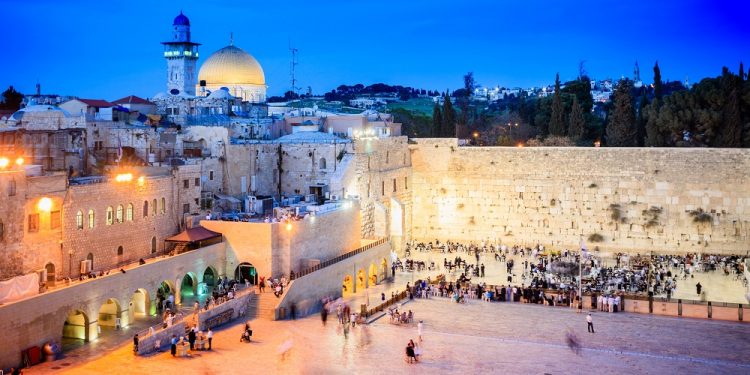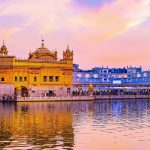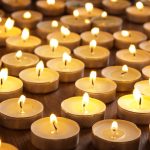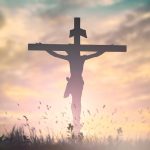
Tisha B’av
Tisha B’Av is a Jewish fast day that occurs on the ninth day of the month of Av, or if that day happens to be Shabbat, then on the 10th day of Av. This places the fast day somewhere between the latter half of July and the beginning of August on the Gregorian calendar. It’s a day that commemorates the five calamities that have befallen the Jewish people throughout history. It’s observed with mourning, prayer, fasting, and refraining from work or personal pleasures.
The History of Tisha B’Av
Tisha B’Av as a fast day has been observed since the 5th century BCE and has been observed in some form ever since. Although it primarily commemorates the destruction of the First and Second Temples that were destroyed (the First Temple in 586 BCE by the Babylonians and the Second Temple in 70 CE by the Romans), it is also appropriate for other tragedies to be observed on this day, and these tragedies have been added over the years.
The First Temple was built by King Solomon, and according to tradition, these plans were handed down to his father King David from God. King David had wanted to build the Temple but was told that his son would be the one to do it. In 832 BCE, King Solomon began construction on it at the site chosen by King David, the top of Mount Moriah.
Tens of thousands of workers were required to build the Temple. Cedar trees from Lebanon were cut down and brought to the site, and stones were sourced from local quarries. Craftsmen from Tyre were brought in to work on the project. It took seven years to complete, and in 825 BCE, King Solomon dedicated the Temple and everything within it.
The Ark of the Covenant was brought into it, and celebrations lasted for seven whole days. Over the next 410 years, the Jewish people would bring offerings to the Temple and gather to “see and be seen by the face of God.”
The History of the Five Calamities
According to the Mishnah (Ta’anit 4:6), five different events occurred on the 9th of Av to warrant fasting on this day. The first was the punishment from God that kept a generation from entering the Promised Land after the Israelites despaired over a disparaging report from spies. The second was the destruction of the First Temple built by King Solomon by Nebuchadnezzar in 586 BCE.
The third was the destruction of the Second Temple built by Ezra and Nehemiah in 70 CE by the Romans. The fourth was the crushing of Bar Kokhba’s revolt and the destruction of the city of Betar—an event that killed over half a million Jewish civilians in 135 CE. The fifth and final one was the plowing of the site of the Temple in Jerusalem and the surrounding area by the Roman commander Turnus Rufus.
Other Calamities Observed on Tisha B’Av
Those were the initial calamities that necessitated this fast day, but over the years, other tragedies have been added that also occurred on the 9th of Av. References to some of these events have appeared in the liturgy for this fasting day, and we’ll list some of them below.
The First Crusade on August 15, 1096, killed 10,000 Jews in its first month and destroyed Jewish communities in the Rhineland and France. On July 18, 1290, the Jews were expelled from England. On July 22, 1306, the Jews were expelled from France. On July 31, 1492, the Jews were expelled from Spain. On July 23, 1942, the mass deportation of Jews began from the Warsaw Ghetto. Even though the Holocaust spanned several years, most Jewish communities use Tisha B’Av to mourn the 6 million Jewish victims.
Customs & Observances of Tisha B’Av
When Tisha B’Av falls on Shabbat, it’s delayed, and the observance of this day is held on the following day—a Sunday. The fast held on this day begins just before sunset on the preceding evening and continues until nightfall of the day of Tisha B’Av.
The main prohibitions on this day don’t just include eating and drinking. People are also forbidden from washing or bathing, applying oils or creams to their skin, having marital relations, and wearing leather shoes. These restrictions may be waived in the case of health issues, but a rabbi versed in Jewish Law must first be consulted. For example, people who are ill may be allowed to drink and eat.
It’s also forbidden to study the Tanakh, except for the distressing texts such as the Book of Job, the Book of Lamentations, and the chapters of the Talmud that discuss the destruction of the Temple. Before the start of evening services in the synagogue, the parochet is drawn aside until the last Mincha prayer service.
If possible, work is to be avoided during this holiday. Electric lighting should be dimmed or turned off, and the participant may recite the Kinnot by candlelight. It’s also customary for people to avoid greeting one another or sending gifts to one another. If Torah scrolls or old prayer books need to be disposed of, they are usually buried on this day.
Prayer Services of Tisha B’Av
On the morning of Tisha B’Av, the Book of Job is read by many Sephardic congregations. There is a tradition for those who have been called to read on this day that they do not receive the usual congratulations that speakers usually receive for this honor. There is also a tradition for those being called to read from the Torah in the Tisha B’Av morning service to also be called in to read for the evening service.
The purpose of this is that the morning reading reflects the calamities of the events observed on this day, and the afternoon reading is meant to offer a form of consolation. During the evening services in the synagogue, the scroll of Eicha is read.
Most of the morning of Tisha B’Av is spent reading Kinnot or chanting. Some people refer to the disasters after the exile, and others mourn the loss of the Temples. The poems in the Kinnot mourn the destruction of both the First and Second Temples in Jerusalem, the Expulsion of Jews from Spain, and the events of the Holocaust. The Kinnot is recited on the night of Tisha B’Av, after reciting from the Book of Lamentations.
Added to the end of the blessing Boneh Yerushalayim is a paragraph that begins with Nachem or Console. The Boneh Yerushalayim is recited during the Amidah and elaborates on the mournful state of the Temple and Jerusalem. In modern times, some Conservative and Orthodox rabbis have proposed amending Nachem because they feel that it no longer reflects the current state of a rebuilt Jerusalem under the sovereignty of Israel.








